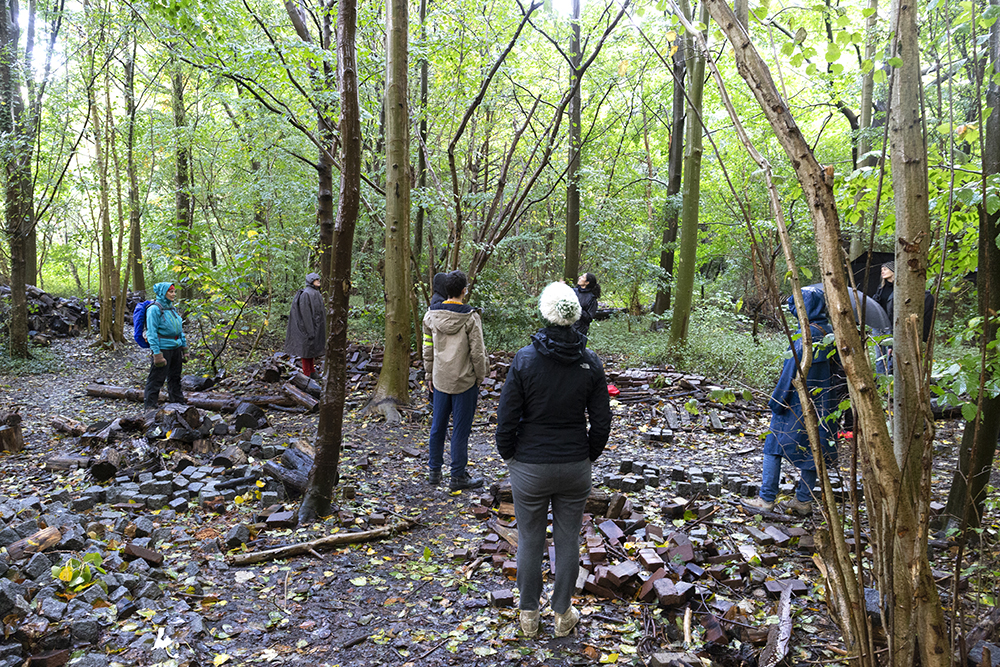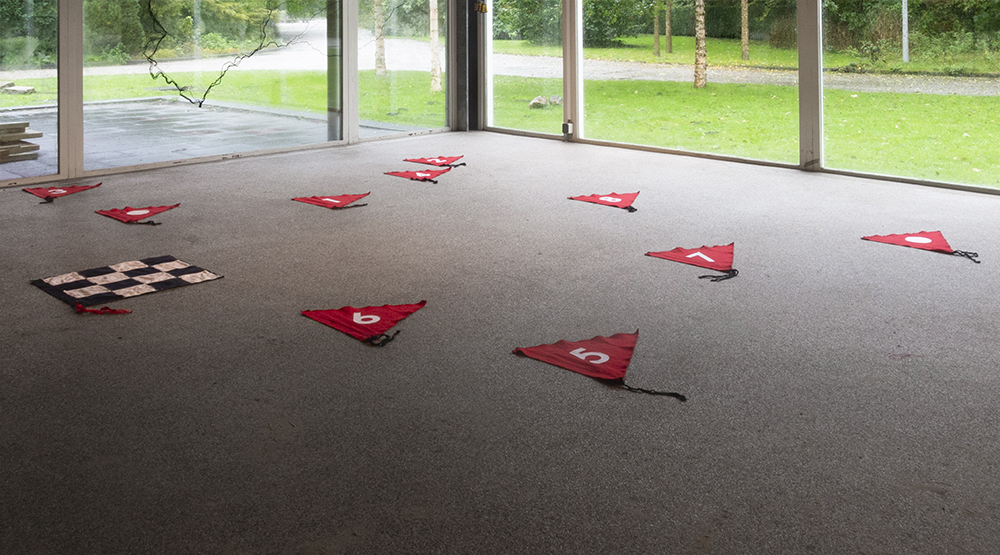Mind Your Step
a group exhibition (and public programme) about the art of walking
the Glass House and surroundings
October 4 – November 29, 2020 (finissage 29 November)
-> please note: we are not open on 7 & 8 en 14 & 15 November due to the new corona measures of the government
Featuring: Tim Knowles, Tom Bekkers, Iris Hoppe, Justin Bennett, Chikako Watanabe, Naomi Bueno de Mesquita, Liesje van den Berk, Malú Cayetano Molina & Sonia Pérez, Ienke Kastelein, Isolde Venrooy, Esther Hovers
“All truly great thoughts are conceived by walking” – Friedrich Nietzsche
The exhibition Mind Your Step was supported by Gemeente Amsterdam, Prins Bernard Cultuurfonds, Mondriaanfonds, AFK and Stroom.
Images: Ilya Rabinovich
Is there a connection between our heads and our feet? Can walking lead to a better understanding of ourselves and the world around us? Philosophers, writers and artists have been pondering these questions for centuries. Kierkegaard was convinced that the mind functions best at a walking pace of 4.5 kilometers per hour.
This autumn, we wander off the beaten track with Mind Your Step: an exhibition and public programme centered on the art of walking. We’ll be featuring an exhibition in the Glass House as well as walks and audio tours developed by the artists. Put on your walking shoes!
The curated walks will be documented with maps, drawings and other documentation. All will be displayed in the Glass House, so that the exhibition itself will constantly keep developing in connection with the world outside.
Exhibition in the Glass House
Tim Knowles examines movements through the landscape, to depict the relationships between things. The video installation In Search of the Miraculous II by Tom Bekkers consists of 5 filmed performances recorded in the Wadden area. The artist reflects on climate change while walking and slowly sinking deeper into the mud. Iris Hoppe presents a new version of Rundgang / Walk Round, a stroll with a double point of view through the streets of Amsterdam and Zuid-Kennemerland simultaneously. Chikako Watanabe will develop an installation outside the Glass House during the course of the exhibition. The artist interweaves different stories from the park, with a little help from our visitors. Visitors will be able to follow the developments in Naomi Bueno de Mesquita’s web app Walkaway in real time on a screen.
Curated walks, audio tours and walks & talks in the Amstelpark
Liesje van den Berk takes the visitor on a walk in the park to experience their surroundings through drawing rather than through a telephone lens (no drawing experience or talent required). Naomi Bueno de Mesquita’s web app Walkaway allows users to ‘erase’ streets on a map of Amsterdam by walking through them, which can be followed in real time on a screen in the Glass House. Justin Bennett has been recording the barely audible sounds of trees and plants in the park for us to listen to in his audio walk Secret Signals. Malú Cayetano Molina & Sonia Pérez take participants on an exploratory walk in Atmospheres (Body as Sensors): how does the human body, like a sensor, pick up signals from its surroundings? Ienke Kastelein stimulates the senses with the twilight walk Don’t Walk Into The Woods At Night and takes the lead in the cheerful happening Walking White Chairs.
Isolde Venrooy’s instructions invite us to find new connections and possibilities in the world around us, while Esther Hovers developed an audio tour for a different take on the city, during a walk from the Amstelpark to the neighboring Zuidas.
More information and public program
Read on for more information about the artists and their projects or click through to the Public Program with all the individual events that will take place next to the exhibition and the walks.
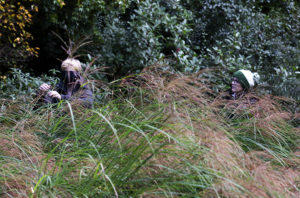
Image: Ilya Rabinovich
Artists
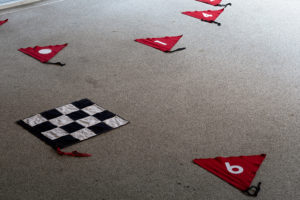
Image: Ilya Rabinovich
Tim Knowles,
Paths of Least Resistance
Windwalk – 7 dials – Waiting for Godot
Track#1
Tim Knowles works with various media, photography, video, drawing and light installations to explore our movements across the land. Knowles creates process-oriented work based on chance and environmental elements. In his projects he incorporates experiences of nature in which he uses phenomena such as wind and weather. In het Glazen Huis, he shows three works:
Path of Least Resistance acted as a mechanism to dictate people’s routes, walking
in an unknown, uncharted way. Whilst the starting points and the finish were known,
the route was directed by a set of rules and the landscape itself. Participants walked
as if they were water running off the land, trying to find its way down to the sea
pulled by gravity. Each individual carried a GPS logger that recorded their path. This data was then used to create a drawing built up of the multiple tracks, revealing the nature of the landscape and the participants adherence to the rules.
Windwalk – 7 dials – Waiting for Godot is part of a series of walks directed by the wind using an array of mechanisms, filmed and plotted by GPS. The drawing, presented on the windows, shows how as the meandering route of the windwalker (guided solely by the wind by way of a sail connected to a helmet) collides with buildings, walls, railings, ventilation shafts, parked vehicles, to reveal glimpses of the city’s structure. The drawing is being shown together with the wind helmet and a photograph.
In Track 1 the artist followed traces of human passage through the landscape. This sequence of signs -broken bracken, bent grass, footprints, snapped twigs, depressed moss, broken stones and dislodged rocks – became the trigger for a sequence of photographs capturing these signs or markers framed within the landscape. Presented in sequence on the floor in a forensic manner, as a whole all the images reveal the process of the small signs that acted as triggers of a journey made by an unknown person through open countryside.
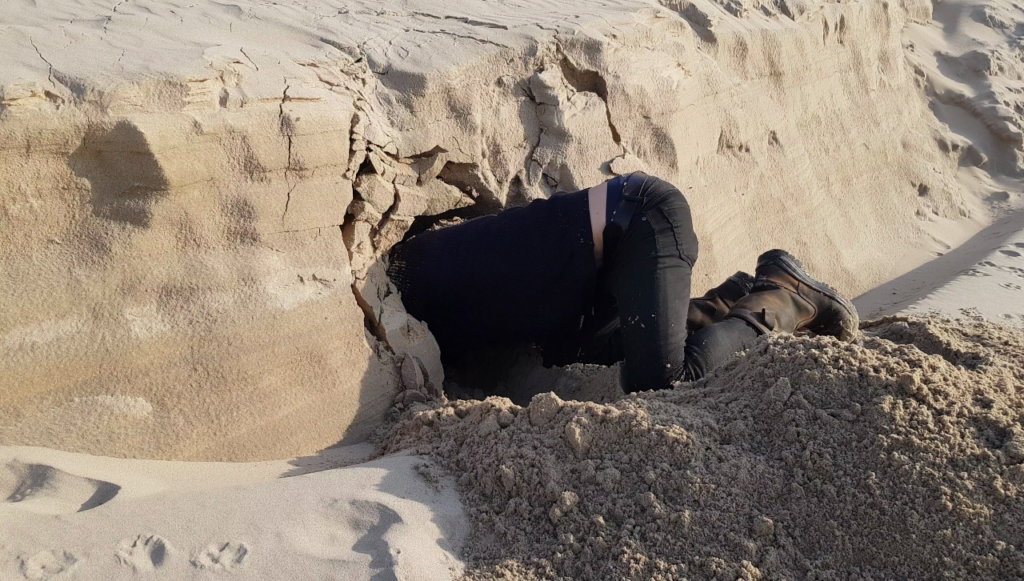

Foto: Tom Bekkers en Ilya Rabinovich
Tom Bekkers, In Search of the Miraculous II
This video installation consists of five filmed performances in the Wadden area. As we become more and more aware of the dying of nature, the artist argues, we have begun a collective process of mourning in which we try to find new ways to connect ourselves with what we called nature. In Search of the Miraculous II is a video installation, consisting of five pedestals with tablets and a central horizontal large screen. In the central video image you can see the feet of the artist, filmed as he tries to walk to a Wadden island. During his wanderings he tells about his reflections on climate change, the Anthropocene and his role in this larger whole. For this he uses a parallel with the grieving process that follows the death of nature. During his story he gets stuck deeper and deeper in the mud: it becomes clear that as a human being he is completely meaningless in this environment that is hostile to humans. In the accompanying performances that can be seen on the five tablets, you see different phases from denial to acceptance of his grieving process. The sound during the installation is played through headphones, which isolates the visitor from the environment. The relationship between the materiality of the body with the environment and the process of knowledge production, as a knowing body, is brought into action here in a complex performative way.

Foto: Iris Hoppe
Iris Hoppe, Rundgang / Rondwandeling / Circuit 2020
Circuit is based on an older film installation made in 1996 consisting of two Super-8 films projected into each other – an image within an image -, shot from two different points of view during a walk by the artist through streets in Amsterdam and the surrounding area.
In this re-staging, Iris Hoppe’s daughter walks through the same streets as then. The two walks are placed parallel to each other in the new work. – An experience of multiple conjunctions about the meaning of time. This installation with 4 projection screens is being projected in the back room of het Glazen Huis.
About the artist
Iris Hoppe born 1970 in Solingen (DE) studied autonomous visual art at the Gerrit Rietveld
Academy in Amsterdam. Hopper’s work includes time-based installations, participatory art in public space, in situ and performance. She examines different kinds of boundaries, such as those between people, mental boundaries, spatial boundaries and those of art spaces and artistic productions. A methodical feature in her work is the inclusion of family members, friends, colleagues or passers-by as direct protagonists of the projects.

Image: Justin Bennett
Justin Bennett, Secret Garden
Secret Garden is a locative audio walk which was developed for Zone2Source in 2015 and will be revised for this occasion. Using an app and headphones, listeners are free to explore the hidden layers of sound spread over the Amstelpark. The sounds are all recorded on location using a wide range of techniques that explore the boundaries of audibility. Vibrations in plants and trees, hidden echoes and the calls of underwater insects form the soundtrack to the walk.
Justin Bennett (1964, UK) studied sculpture and electronic music and works with sound and image. His work with sound combines spatial recordings of environmental sound with the resonances of buildings and materials. He often uses these recordings together with spoken words to immerse the audience in a story or to subtly change their perception of a place. Bennett and much of his work combines the two aspects of sound and space. Bennett makes work for public spaces as well as art spaces and concert venues. He teaches at the Institute of Sonology and is a member of Jubilee, platform for artistic research in Brussels.
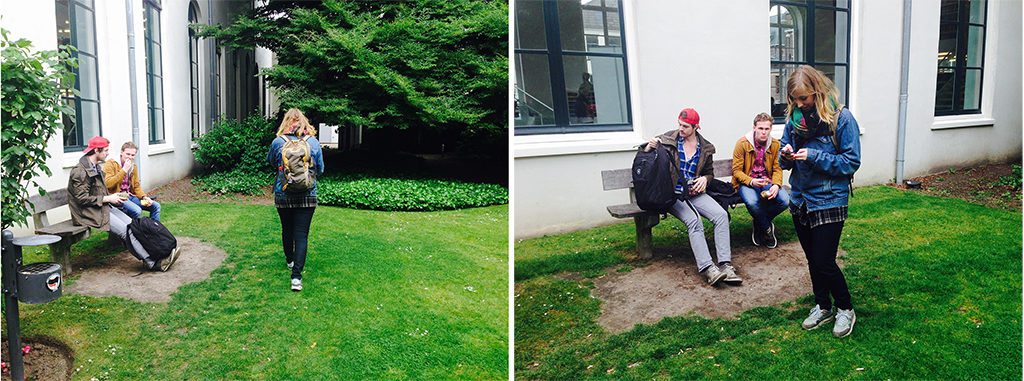
Image: Naomi Bueno de Mesquita
Naomi Bueno de Mesquita, Walkaway
instructions
Using a mapping interface, people can erase the map of their city along their walking trajectories. With this work, artist and design researcher Naomi Bueno de Mesquita points to the participatory quality of performative cartography (partially due to the digitization of maps and mapping software) emphasizing how in particular digital mapping in real- time can be used as a tool that allows for collective co-authorship on spaces, agency and appropriation.
Through the ability to erase the city’s map, the interface is explored for its potential to work against the notion of control that is inherently coupled with map making, in both way-finding but also in practices of data-aggregation or data-accumulation. A physical movement in, what Henri Lefebvre (1991) calls, the ‘lived space’ continuously overrides the ‘conceived space’ – the space that is theorised, such as that of a map1 – with which the map app enables to scrutinize ingrained dispositions that we hold when it comes to what a map ought to be or do.
The evolving (erasure of the) digital map as well as videos users are invited to take during their itinerary can be viewed continuously on three screens from outside het Glazen Huis or by going to a website. Participants in this project become the authors of the map and this way decide collectively how the map evolves throughout the two months that the exhibition takes place, while the videos give insight into individual motives and/or the experiences of erasing. The map app can be used anywhere and at any time in the city of Amsterdam for the two months duration of the exhibition Mind Your Step. Using the map app requires no registration with which users stay anonymous.
This work forms part of Naomi Bueno de Mesquita´s PhD (KU Leuven) on critical cartography and performative modes of mapping as a means to re-engage with (physical) public space. Performative cartography alludes to the performative turn in cartographic theory, where maps are studied as (interactive) performances and as products of co-creative relationships between maps and users. Bueno de Mesquita designs map apps as research tools to engage—together with the public/participants—in questions of representation and (in)visibility with the eventual aim to renegotiate public space and its social constructs.
WALKAWAY
Using a mapping interface, people can erase the map of their city along their walking trajectories. A physical movement in which the map app enables to scrutinize ingrained dispositions that we hold when it comes to what a map ought to be or do.
mindyourstep.performativemapping.net
performativemapping.com
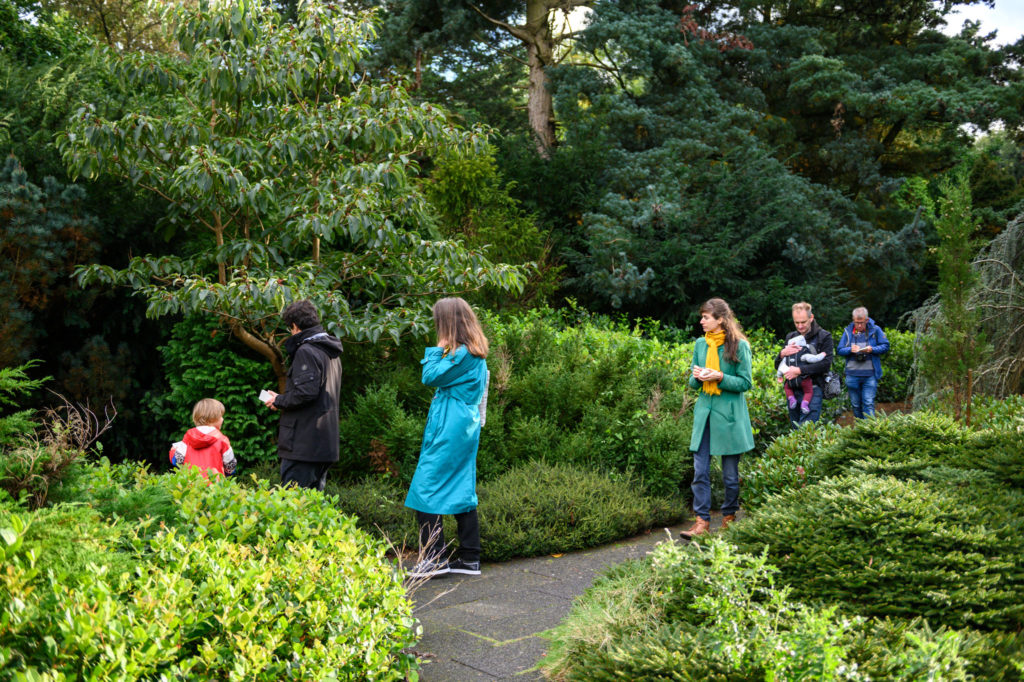
Image: Tom Jansssen
Liesje van den Berk, Line – off – line
Drawing walk
Sign up
Step-by-step, line-by-line, everything is possible on a blank paper. Exit your comfort digital bubble and leave your phone behind. Feel, see, smell, hear and experience with your pencil on this drawing walk.
In the performative drawing walk “Line – off – line” we enter into a dialogue with the Amstelpark and each other through drawing actions. Anything is possible on white paper. Exit your comfort digital bubble and leave your phone behind. Feel, see, smell, listen and experience with your pencil on this drawing walk.
This performance is a counter-reaction to telephone use in our current society. We hold our phone like a precious object. Less conversations or open friendly looks when we are on the road, just desperately staring at the phone looking for contact elsewhere. Where are we? Through telephone we are often in multiple worlds and realities at the same time, but are we still really HERE?
In this walk, Liesje van den Berk asks the participants to temporarily replace their telephone for a blank paper telephone and graphite pencil to walk and draw in silence and concentration in the Amstelpark. During the walk Liesje gives specific sensory drawing instructions. In this performance drawing is a way to actively experience the richness of your environment and make connection. By sharing drawings, Liesje creates a dialogue between the participants about their environment. Slowly the individuals become a group. At the end, the participants share one of their drawings on a map of the Amstelpark. These drawings are left behind in the Amstelpark to show a part of the walk, a memory of a moment, to the other visitors of the park.
About the artist
In her (drawing) performances and drawings, Liesje van den Berk creates a moment for dialogue, often non-verbal, in which she focuses on personal contact, attentive presence and physical, sensitive involvement of herself and the audience. This creates dialogues, not only with other people (through performances), but also with the environment (through drawings and performances). Liesje van den Berk has developed the drawing method Drawalks to observe and record the environment through sensory experiences and (walking) drawing. The focus is often on senses other than sight – such as smell, sound and touch – to gain new perceptions of the environment.

Image:Isolde Venrooy
Isolde Venrooy, Pathfinder
Pathfinder consists of ten silkscreen cards with walking instructions, a handmade paper object and a map that are available in and outside of het Glazen Huis. The texts on the cards direct the walker’s senses in various ways – either by questioning or by guiding in a welcoming manner. The instructions evoke a brief action or movement of thought, which activates the senses and sets body and mind in motion. This leads to walks, in the Amstelpark, that offer new opportunities for relationships and connections between the visitor and her environment. The straightforward instructions function as poetic suggestions for alternative scenarios that can be put into practice. They invite the participant to act: to become active, anticipate, entwine, re-situate. By walking slightly differently, self-evidences are put into question and alternative possibilities explored. The walks “de-filter” looking and extend it with other ways of perception.
Pathfinder is about sensory experiencing variations to obvious points of view and positions – and about the pleasure of discovery. The walking instructions are inspired by a reciprocal relation between text and site. Isolde’s renewed interest in her Indonesian family history made her rethink relations between body and place and the influence of language on perception.
about the artist
Isolde Venrooy’s artistic practice includes paintings, installations and walks. Her interest in walking stems from a longing for interaction between her visual work, the human body and the environment. In her artistic practice, walking is a medium and “viewing tools” direct the senses. In addition to moving, pausing, determining position, looking and walking on, the “viewing tools” function as extensions of observation.
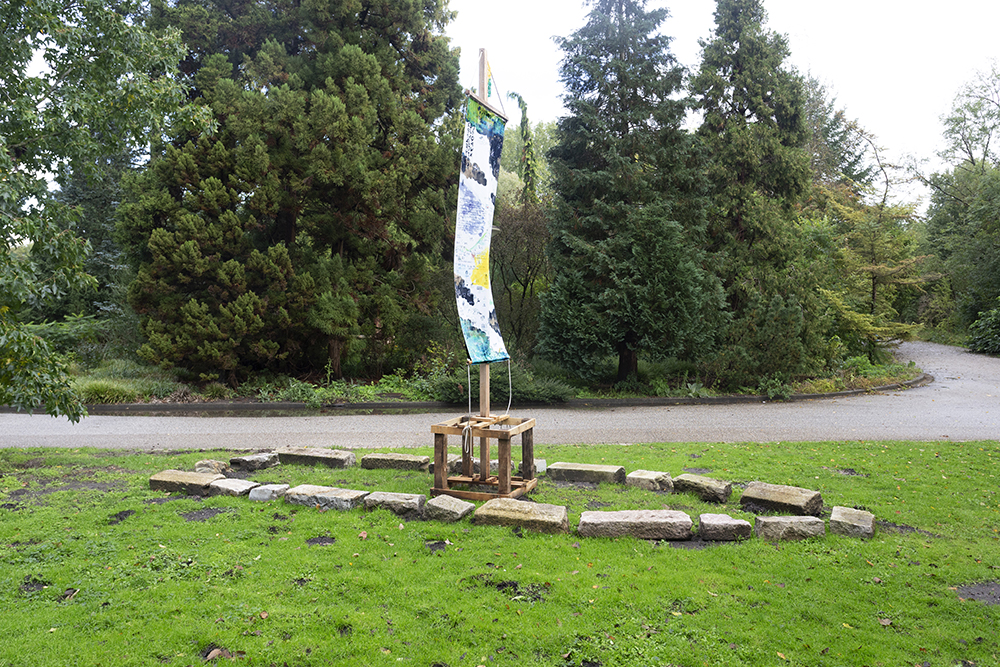
Chikako Watanabe, Journey to Meet Star-Gazers, Amsterdam, 2020
Chikako learned how to weave nets from a fisherman in Enkhuizen. Since then she has been using this technique in her work, placing nets on various location during her projects. In 2019, she was netting nets with people living around Mt. Nose Myoken, in Japan. Based on the research she conducted in the areas outside of Nose, she made relations between customs that seem remote from each other, such as the holy place Mt. Nose Myoken and its history of beliefs and the fishermen and nomads, who look at the stars as their guide for navigation. A similar research project she will conduct around the history of the area of the Amstelpark. Amsterdam was built as a fishing village in the late 12th century. Chikako read about a legend in which it is said that two hunters/fishermen on a small boat with dogs landed on the banks of the Amstel River and built it. For this exhibition she will use the net she wove as a guide. She composes imaginary pathways which include stories from her research while walking around Amstelpark along the old shape of Amstel River. Visitors of the park follow the nets hung on the tree to share the stories from East until West. During the exhibition she will continue her research into the history of the area while weaving an itenary of nets in the Amstelpark. At the end of the exhibition she will develop an event Journey to Meet Star-Gazers, Amstel, 2020.
About the artist
After the Japanse artist Chikako Watanabe moved in 1995 to Amsterdam she made new work in many places by learning from the local inhabitants. By use media such as fashion, drawing, photography and video she made installations that functioned as interactive platforms in which she worked together with various people in the form of performances and workshops. Her theme is always local communication. The objective of her project is stimulating social interaction and creating new communication possibilities for people within modern society. Small questions and curiosity for daily life are her primary inspiration.
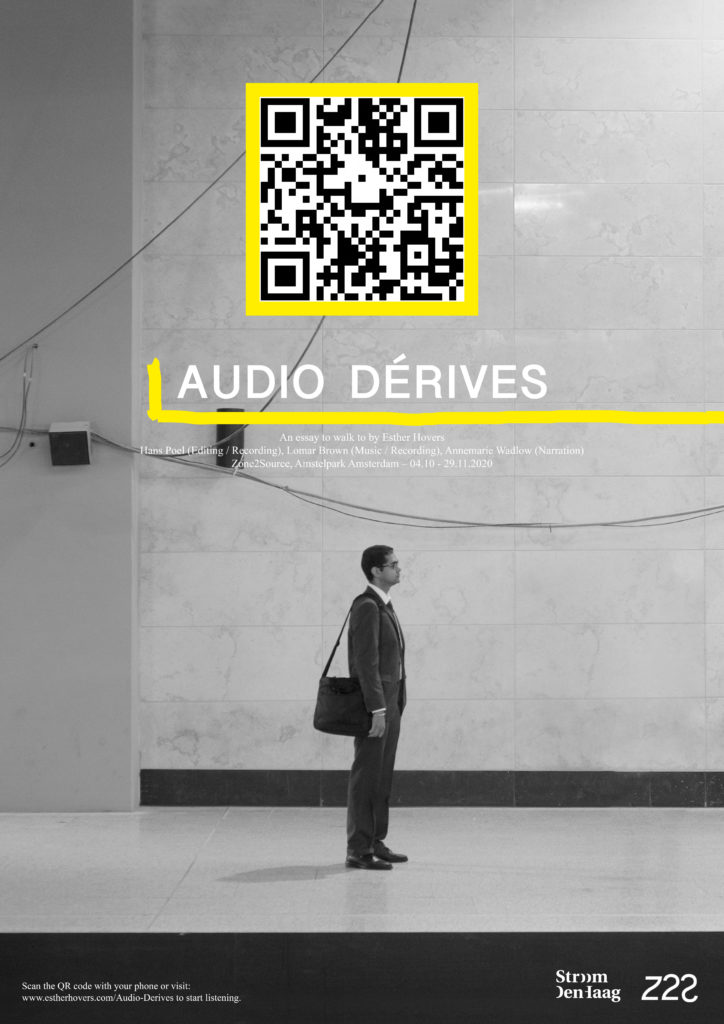
Esther Hovers, Audio Dérives
In Audio Dérives the audience is turned into the performer. This audio walk takes the listener from the Amstelpark to Amsterdam’s financial district the Zuidas. Guy Debord’s Theory of the Dérive (1956) is introduced while reflecting on the immediate surroundings and architecture of the neighborhood. This solitary experience examines the poetry of walking in the urban environment. Solitary walks took on a different meaning during the pandemic. While the digital realm gained dominance within our daily lives, public space became one of the few places where art could be experienced safely. Audio Dérives uses text and original music to offer a refuge from the digital space that seemed so dominant during lock-down. The audio walk can be walked any time of the week with your own smart phone and headset by downloading a QR code on a poster outside of het Glazen Huis which forms the start point of the expedition.
Concept / Script – Esther Hovers, Editing / Recording – Hans Poel, Music / Recording – Lomar Brown, Narration – Annemarie Wadlow.
About the artist
In her artistic practice, Esther Hovers investigates how power, politics and control are exercised through urban planning and the use of public space. She was trained as a photographer but creates installations in which photographs, drawings, text and film play an equal part.
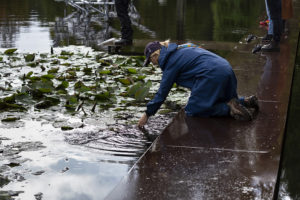
Image: Ilya Rabinovich
Malú Cayetano & Sonia Pérez
CITY IN BODY: Part II. Atmospheres (body as a sensor)
Sign up
Because there is no place without a self and no self without place, we are landscape.
This project of curated walks aims to explore the indivisible relation between body and landscape through the concept of “atmosphere”. Atmospheres are felt, they constitute experiences that require a spatial setting, human bodies, exterior events, shared meanings and histories. This concept enables us to overcome the polarity between subject and object, body and environment: we are immersed in atmospheres, always affected by them. For Mind Your Step the artists explore the spatial atmospheres of Amstelpark and its surroundings, using the body as an instrument to sense the environment and trigger an embodied and affective experience of the park.
The artists design a routine to guide participatory walks along the park during the exhibition period. The routine consists of a set of exercises rooted in Body Weather, fostering the feeling of being together with other beings and things in a shared space. These experiences will be silently registered with the help of a portable device. The device will have various sensors that can record myriads of parameters. These will be spatially linked to the park and added to a responsive map on view in het Glazen Huis. This cartography will be shown as an ongoing visualization of possible atmospheres in Amstelpark; it will evolve thanks to the active participation of the audience in the walks.
This exercise has been envisioned by Malú Cayetano (landscape architect) with the support of Sonia Pérez (actress and performer).

Image: Ienke Kastelein
Ienke Kastelein
Sign up
Don’t walk into the woods at night ….
When night falls and the hour of the wolf draws near, a spell is cast. As the light fades slowly and contours dissolve, our nose and ears take over from the eyes. Join a twilight walk in silence, in the Amstelpark after closing time. We feel the bark of the trees. We sense the ground under our feet and allow ourselves to be intoxicated by the scent of the early autumn soil. A wordless conversation might arise between plants, people and trees.
Walking White Chairs
Twelve white chairs are sitting in the Amstelpark. Grab a chair and make a choice – you could sit down in it immediately, or take it with you to a different vantage point. As people and chairs roam around the park, one wonders. What makes people choose a specific spot? How does a chair end up in a given location? What roads does it travel by?
This playful happening was inspired by the 1965 ‘white bicycle plan’ of the Dutch Provo movement. Free white bicycles were to be placed throughout the city, to be used in collective ownership.
On Saturday, the chairs will be placed in the immediate surroundings of the Glass House. They’ll wander on from there, carried away by anyone who wants to. An open invitation to play for anyone who is ambling in the park.

